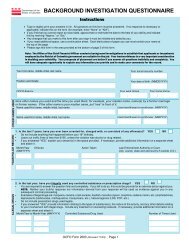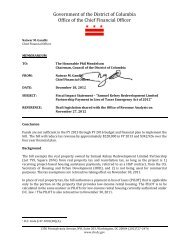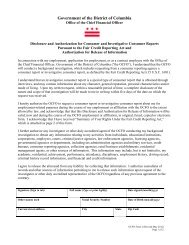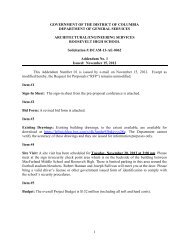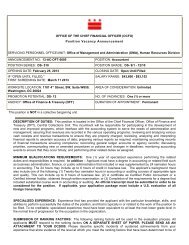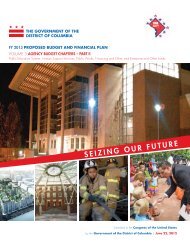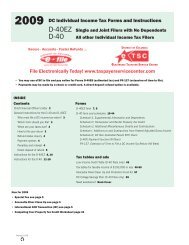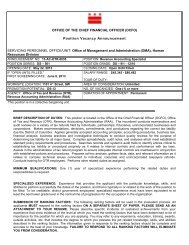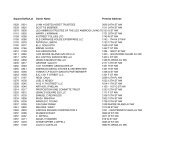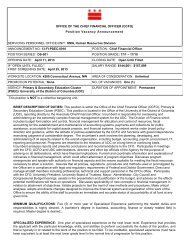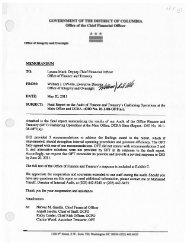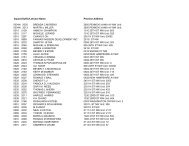Volume 1 - Executive Summary - Office of the Chief Financial Officer
Volume 1 - Executive Summary - Office of the Chief Financial Officer
Volume 1 - Executive Summary - Office of the Chief Financial Officer
You also want an ePaper? Increase the reach of your titles
YUMPU automatically turns print PDFs into web optimized ePapers that Google loves.
32e. Transfer to Highway Trust Fund (Enterprise Fund). This line in Table 3-3 reflects transfers <strong>of</strong> dedicated<br />
motor fuel tax to <strong>the</strong> Highway Trust Fund outside <strong>of</strong> <strong>the</strong> General Fund.<br />
32f. Transfer to WMATA (Washington Metro Area Transit Authority). This line in Table 3-3 reflects transfers<br />
<strong>of</strong> parking sales and use tax revenues to WMATA to support <strong>the</strong> operations <strong>of</strong> <strong>the</strong> agency.<br />
32g. Transfer to Highway Trust Fund. This line in Table 3-4 reflects transfers <strong>of</strong> rights-<strong>of</strong>-way revenue to <strong>the</strong><br />
Highway Trust Fund.<br />
33. Operating Impact <strong>of</strong> CIP. This line in Tables 3-1 and 3-2 reflects <strong>the</strong> estimated cost <strong>of</strong> operating and maintaining<br />
newly completed capital projects. See <strong>Volume</strong> 6 – FY 2012 – FY 2017 Capital Improvements Plan for<br />
details.<br />
34. Total Expenditures and Transfers. This is <strong>the</strong> sum <strong>of</strong> lines 28 to 33.<br />
35. Operating Margin before allocation to reserves. This line is <strong>the</strong> difference between lines 17 and 34 showing<br />
<strong>the</strong> surplus or deficit after subtracting total expenditures and transfers from total resources.<br />
36. Reserved for subsequent years’ expenditures. This reflects <strong>the</strong> same amount as in line 10, in <strong>the</strong> prior years’<br />
operating margin.<br />
37. Cash Flow Reserve Account. This Account was established by section 47-392.02(j-2) <strong>of</strong> <strong>the</strong> District <strong>of</strong><br />
Columbia Official Code. The Fiscal Year 2011 Budget Request Act <strong>of</strong> 2010 authorizes 50 percent <strong>of</strong> <strong>the</strong> undesignated<br />
end <strong>of</strong> year fund balance to be deposited in this account. In FY 2012, under <strong>the</strong> section heading “Revised<br />
Revenue Estimate Contingency Priority,” this same act authorizes <strong>the</strong> first $21.6 million <strong>of</strong> additional revenues for<br />
<strong>the</strong> purpose <strong>of</strong> shifting <strong>the</strong> funding source for employees in <strong>the</strong> capital budget to <strong>the</strong> operating budget. 50 percent<br />
<strong>of</strong> <strong>the</strong> remaining additional revenue, $27.8 million, will be used as directed in <strong>the</strong> section “Subtitle Q. Contingency<br />
for Additional Revenue.” The remaining $27.8 million plus 50 percent <strong>of</strong> <strong>the</strong> operating margin, $676 thousand,<br />
will be recorded in <strong>the</strong> Cash Flow Reserve Account. FY 2013 to FY 2016 reflects 50 percent <strong>of</strong> <strong>the</strong> Operating<br />
Margin in this account.<br />
38. Fiscal Stabilization Reserve Account. This Account was established by section 47-392.02(j-1) <strong>of</strong> <strong>the</strong><br />
District <strong>of</strong> Columbia Official Code. The Fiscal Year 2011 Budget Request Act <strong>of</strong> 2010 authorizes 50 percent <strong>of</strong><br />
<strong>the</strong> undesignated end <strong>of</strong> year fund balance to be deposited in this account. FY 2012 to FY 2016 reflects 50 percent<br />
<strong>of</strong> <strong>the</strong> Operating Margin in this account.<br />
39. Operating Margin, Budget Basis. This is <strong>the</strong> difference between Total General Fund Resources (line 17)<br />
and <strong>the</strong> total <strong>of</strong> Expenditures (line 34), reserved for subsequent years’ expenditures (line 36), <strong>the</strong> Cash Flow Reserve<br />
Account (line 37) and <strong>the</strong> Fiscal Stabilization Reserve Account (line 38). In Tables 3-1 and 3-2, FY 2015 reflects<br />
$19 million proposed to be set aside for subsequent years expenditures. In Table 3-3 this line reflects unbudgeted<br />
revenues from dedicated taxes.<br />
40. Line intentionally left blank.<br />
Composition <strong>of</strong> Cash Reserves<br />
42. Emergency Cash Reserve Balance (2 percent). The District was required to establish an Emergency<br />
Reserve, by <strong>the</strong> end <strong>of</strong> FY 2004, equal to 4 percent <strong>of</strong> <strong>the</strong> District's Local expenditures. The requirement was<br />
satisfied in FY 2002. In FY 2005, <strong>the</strong> requirement was changed to 2 percent, and <strong>the</strong> base for <strong>the</strong> calculation was<br />
also changed.<br />
FY 2013 Proposed Budget and <strong>Financial</strong> Plan<br />
<strong>Financial</strong> Plan<br />
3-7



